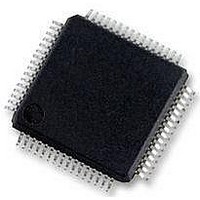MC56F8257MLH Freescale Semiconductor, MC56F8257MLH Datasheet - Page 563

MC56F8257MLH
Manufacturer Part Number
MC56F8257MLH
Description
DSC 64K FLASH 60MHZ 64-LQFP
Manufacturer
Freescale Semiconductor
Series
56F8xxxr
Datasheets
1.TWR-56F8257.pdf
(88 pages)
2.MC56F8245VLD.pdf
(14 pages)
3.MC56F8245VLD.pdf
(2 pages)
4.MC56F8245VLD.pdf
(629 pages)
Specifications of MC56F8257MLH
Core Processor
56800E
Core Size
16-Bit
Speed
60MHz
Connectivity
CAN, I²C, LIN, SCI, SPI
Peripherals
LVD, POR, PWM, WDT
Number Of I /o
54
Program Memory Size
64KB (32K x 16)
Program Memory Type
FLASH
Ram Size
4K x 16
Voltage - Supply (vcc/vdd)
3 V ~ 3.6 V
Data Converters
A/D 16x12b, D/A 1x12b
Oscillator Type
Internal
Operating Temperature
-40°C ~ 105°C
Package / Case
64-LQFP
Product
DSCs
Processor Series
56800E
Core
56800E
Device Million Instructions Per Second
60 MIPs
Maximum Clock Frequency
60 MHz
Number Of Programmable I/os
54
Data Ram Size
8 KB
Operating Supply Voltage
3.3 V
Maximum Operating Temperature
+ 105 C
Mounting Style
SMD/SMT
Minimum Operating Temperature
- 40 C
On-chip Adc
12 bit, 8 Channel
Lead Free Status / RoHS Status
Lead free / RoHS Compliant
Eeprom Size
-
Lead Free Status / Rohs Status
Details
Available stocks
Company
Part Number
Manufacturer
Quantity
Price
Company:
Part Number:
MC56F8257MLH
Manufacturer:
MOTOLOLA
Quantity:
560
Company:
Part Number:
MC56F8257MLH
Manufacturer:
Freescale Semiconductor
Quantity:
10 000
- TWR-56F8257 PDF datasheet
- MC56F8245VLD PDF datasheet #2
- MC56F8245VLD PDF datasheet #3
- MC56F8245VLD PDF datasheet #4
- Current page: 563 of 629
- Download datasheet (4Mb)
Chapter 16 System Integration Module (SIM)
16.3
Functional Description
16.3.1 Clock Generation Overview
The SIM uses master clocks from the OCCS module to produce the peripheral and
system (DSC core and memory) clocks. A mstr_2x clock input from OCCS operates at
two times the system and peripheral bus rate and therefore a maximum of 120 MHz.
Peripheral and system clocks are generated at a maximum of 60 MHz by dividing the
mstr_2x clock by 2 and gating it with appropriate power mode and clock gating controls.
The TMR and SCI peripheral clocks can optionally be generated at two times the normal
rate, at a maximum of 120 MHz. These clocks are generated by gating the mstr_2x clock
with appropriate power mode and clock gating controls.
The OCCS configuration controls the operating frequency of the SIM's master clocks. In
the OCCS, an external clock (CLKIN), a crystal oscillator, or the relaxation oscillator can
be selected as the master clock source (mstr_osc). An external clock can be operated at
any frequency up to 120 MHz. An external clock is presented directly to the SIM as the
mstr_2x clock, so the duty cycle of the high-speed peripheral clock would reflect the
precision of the duty cycle of the external clock. The crystal oscillator can be operated at
between 8 MHz and 16 MHz. The relaxation oscillator can be operated at full speed (8
MHz), standby speed (400 kHz using ROSB), or powered down (using ROPD). An 8
MHz or 16 MHz mstr_osc can be multiplied to 240 MHz using the PLL and postscaled to
provide a variety of speed clock rates. Either the postscaled PLL output or mstr_osc
signal can be selected to produce the master clocks to the SIM.
In combination with the OCCS module, the SIM provides power modes (see the
following section), clock enables (PCEn registers, SDn registers, CLKDIS, ONCEEBL),
and clock rate controls (TMRn_CR, SCIn_CR) to provide flexible control of clocking
and power use. The SIM's PCEn peripheral clock enable controls can be used to disable
individual peripheral clocks when they are not needed. The clock rate controls enable the
high speed clocking option for the general-purpose timers and the SCIs. See the OCCS
chapter for further details.
16.3.2 Power Down Modes Overview
The 56800E DSC core operates in the power modes shown in the following table.
MC56F825x/4x Reference Manual, Rev. 2, 10/2010
Preliminary
Freescale Semiconductor
563
Related parts for MC56F8257MLH
Image
Part Number
Description
Manufacturer
Datasheet
Request
R
Part Number:
Description:
Manufacturer:
Freescale Semiconductor, Inc
Datasheet:
Part Number:
Description:
Manufacturer:
Freescale Semiconductor, Inc
Datasheet:
Part Number:
Description:
Manufacturer:
Freescale Semiconductor, Inc
Datasheet:
Part Number:
Description:
Manufacturer:
Freescale Semiconductor, Inc
Datasheet:
Part Number:
Description:
Manufacturer:
Freescale Semiconductor, Inc
Datasheet:
Part Number:
Description:
Manufacturer:
Freescale Semiconductor, Inc
Datasheet:
Part Number:
Description:
Manufacturer:
Freescale Semiconductor, Inc
Datasheet:
Part Number:
Description:
Manufacturer:
Freescale Semiconductor, Inc
Datasheet:
Part Number:
Description:
Manufacturer:
Freescale Semiconductor, Inc
Datasheet:
Part Number:
Description:
Manufacturer:
Freescale Semiconductor, Inc
Datasheet:
Part Number:
Description:
Manufacturer:
Freescale Semiconductor, Inc
Datasheet:
Part Number:
Description:
Manufacturer:
Freescale Semiconductor, Inc
Datasheet:
Part Number:
Description:
Manufacturer:
Freescale Semiconductor, Inc
Datasheet:
Part Number:
Description:
Manufacturer:
Freescale Semiconductor, Inc
Datasheet:
Part Number:
Description:
Manufacturer:
Freescale Semiconductor, Inc
Datasheet:











